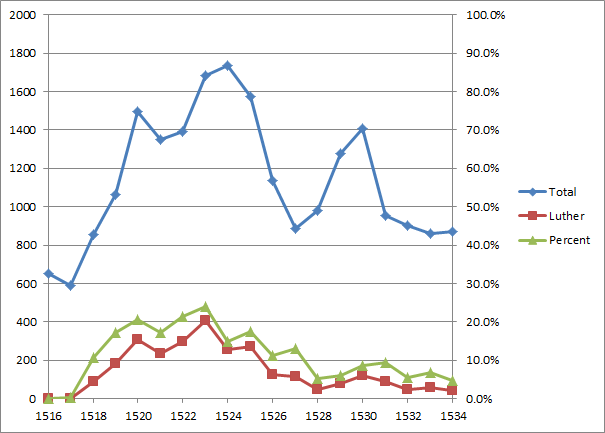In theory, it should be simple. We just need to count a) how many total titles are known to VD16 for the relevant years; and b) how many of these titles are Luther's works; and then divide b by a.
We do have to make a few decisions. For a time period to investigate, we'll choose 1516-1534 in order to avoid as many approximately dated works as possible at either end, which are often dated to round decades or half decades. For works, we'll count titles rather than printed volumes (and therefore count compilations as multiple works with possibly different authors).
Here's what we find:
So 30% looks like it might be too high. In the single highest year, 1523, Luther's works reach 24% of the total, which is still a gigantic percentage for one person's works. But over a slightly longer period, 1519-1525, the average is 19%.
But wait! Titles are not the only way to measure books. What about the amount of paper used? How much of the paper that left German presses during the same time period was devoted to works by Luther?
In theory, it should be simple. We just need to know a) the format of all the German books published between 1516 and 1534; and b) the number of leaves in each of these books; and then find the sum of the total leaves multiplied by the inverse of the format. That is, a 10-leaf folio would use 10 * 1/2 = 5 sheets, while a 200-leaf quarto would use 200 * 1/4 = 25 total sheets. As long as we pretend that all paper sheets were the same size (they weren't) and that all editions had the same print run (they didn't), we can come up with a rough, relative measure of the physical output of German printing presses (to be taken with a large measure of salt, but it's the best we can do for now).
Here's what we find:
In terms of paper usage, Luther's works hover around 10% of the total until 1527-28, when they jump up to 20% and 15%, respectively. What stands out here is that the dramatic leap in titles printed between 1517 and 1524 doesn't seem to correspond to a significant rise in paper usage. It looks like existing capacity was used to produce more but shorter works.
The years 1527 and 1528 are noticeably below the trend in paper consumption, while 1529 and 1530 jump significantly above it. Is this normal volatility, bad coding, or something interesting going on in German printing?
Finally, we shouldn't underestimate Luther's effect on German printing, as authors addressing the Reformation in some way comprise a large segment of print production during these years (and during the sixteenth century as a whole). For 1516-1534, here are the top ten authors and a rough count of their editons:
- Luther, Martin (2780)
- Erasmus, Desiderius (1284)
- Melanchthon, Philipp (484)
- Cicero, Marcus Tullius (247)
- Rhegius, Urbanus (190)
- Hutten, Ulrich von (161)
- Karlstadt, Andreas (152)
- Bugenhagen, Johannes (146)
- Zwingli, Ulrich (141)
- Eck, Johannes (130)


No comments:
Post a Comment